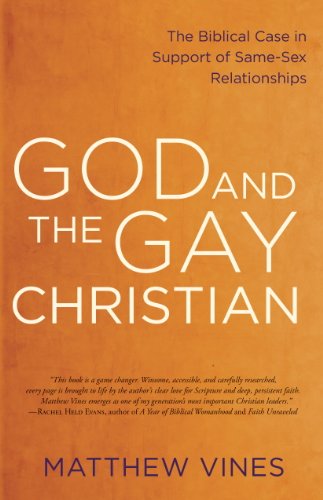The Codependent Conjunction of “Gay Christians” and the Gay-Affirming Church
When Harvard sophomore Matthew Vines came out to his parents over Christmas break, both of them affirmed their unconditional love for him right away. But the news was hard for everyone. As Christians, they believed the same thing the church has held for 2000 years – that homosexuality runs contrary to the created order and is therefore sinful and harmful.
A “shattered soul,” Matthew decided not to return to school for spring semester. Instead, he stayed home and set out “to confront homophobia in my conservative Wichita church and find acceptance there as a gay Christian.” By summer, Matthew’s father had changed his mind, and the family subsequently left their “strongly non-affirming” church for one more amenable to their new outlook.
In March 2012, two years after having set out to confront homophobia in the church, Matthew presented the results of his “thousands of hours of research” in an hour-long talk titled “The Gay Debate.” The upshot of it was this: “The Bible does not condemn loving gay relationships. It never addresses the issues of same-sex orientation or loving same-sex relationships, and the few verses that some cite to support homophobia have nothing to do with LGBT people.” The video went viral (more than three quarter million views to date) and Matthew has been disseminating the content of it ever since.
In 2013, he launched “The Reformation Project,” “a Bible-based, non-profit organization … to train, connect, and empower gay Christians and their allies to reform church teaching on homosexuality from the ground up.” At the inaugural conference, paid for by a $104,000 crowd-funding campaign, fifty LGBT advocates, all professing Christians, gathered for four days in suburban Kansas City for teaching and training, At twenty-three years of age, Matthew Vines was already becoming a formidable cause célèbre.
“An Agenda in Search of an Interpretation”
Now, the same message has been published in his 2014 book, God and the Gay Christian: The Biblical Case in Support of Same-Sex Relationships. Matthew’s larger argument, stated in the introduction, is this: “Christians who affirm the full authority of Scripture can also affirm committed, monogamous same-sex relationships” [emphasis in original]. He divides Christians into two groups based on their views regarding alternative sexualities: affirming and non-affirming, and his goal is to turn non-affirming Christians into affirming ones.
He gives three reasons why non-affirmers should rethink their position:
Reason #1: Non-affirming views inflict pain on LGBT people. This argument is undoubtedly the most persuasive emotionally, but Matthew has produced a Scriptural case for it. Jesus, in his well-known Sermon on the Mount, warned his listeners against false prophets, likening them to wolves in sheep’s clothing. Then switching metaphors he asked, “Do people pick grapes from thornbushes or figs from thistles?” The obvious answer is no, and Jesus’s point was, you can recognize a good or bad tree – and a true or false prophet – by its good or bad fruit. From this, Matthew concludes that, since non-affirming beliefs on the part of some Christians cause the bad fruit of emotional pain for other Christians, the non-affirming stance must not be good.
Reason #2: The biblical writers did not write from a contemporary understanding of sexual orientation. Ancient societies associated homosexuality with sexual excess – as an out-of-control behavior that anyone might engage in out of hedonistic self-indulgence, and not as a fixed, unchosen characteristic. It is this lustful excess that is prohibited, Matthew suggests, and not loving, committed same-sex relationships.
Reason #3: Traditional, non-affirming interpretations, which imply mandatory celibacy for gay Christians, conflict with traditional teachings of celibacy as a spiritual gift freely chosen. Since Jesus affirmed marriage, and since not all are capable of celibacy, the Bible’s teachings regarding marriage must now conform to our understanding of same-sex orientation. Therefore, loving, same-sex relationships must be affirmed.
After presenting these reasons for taking the affirming side of the gay debate, Matthew spends four chapters explaining how the six biblical passages that specifically mention homosexuality actually mean something other than what they say.
Through it all, Matthew maintains that his approach is thoroughly biblical. And in truth, he does draw liberally from Scripture and in many respects seems to understand central biblical themes. But, as I hope you’ve surmised by now, his attempt to ground affirmation of homosexuality in Scripture travels quite a convoluted route. Biblical studies professor Denny Burk summed it up best when he called it “an agenda in search of an interpretation.”
Codependency
Matthew Vines in particular, and LGBTs in general, appear to be drivingly fixated on changing other people’s moral outlook. But why? Why are they distressed over the shrinking subset of Christianity that holds to the traditional ethic of sex? Note that Matthew found an affirming church in his hometown, as can most any LGBT-identifying Christian. Affirming churches abound. Gaychurch.org lists forty-four affirming denominations – denominations, not just individual churches – in North America and will help you find a congregation in your area. Why, then, given all these choices for church accommodation, are Matthew and the Reformers specifically targeting churches whose teachings differ from their own?
One gets the sense that LGBTs really, really need other people to affirm their sexual behavior. Certainly it’s human to want the approval of others, but this goes beyond an emotionally healthy desire for relational comity. Recall Matthew’s plea that non-affirming views on the part of some Christians cause emotional pain for others. He, and all like-minded LGBTs, are holding other people responsible for their emotional pain. This is the very essence of codependency.
The term came out of Alcoholics Anonymous. It originally referred to spouses of alcoholics who enabled the alcoholism to continue unchallenged, but it has since been broadened to encompass several forms of dysfunctional relationships involving pathological behaviors, low self-esteem, and poor emotional boundaries. Codependents “believe their happiness depends upon another person,” says Darlene Lancer, an attorney, family therapist, and author of Codependency for Dummies. “In a codependent relationship, both individuals are codependent,” says clinical psychologist Seth Meyers. “They try to control their partner and they aren’t comfortable on their own.”
Thou Shalt … Affirm?
Which leads to an even more troubling aspect of this Vinesian “Reformation.” Not only are LGBT Reformers not content to find an affirming church for themselves and peacefully coexist with everyone else, everyone else must change in order to be correct in their Christian expression.
This is the classic progression of codependency, and efforts to change everyone else become increasingly coercive. We must affirm same-sex orientation, Matthew says. If we don’t, we are “tarnishing the image of God [in gay Christians]. Instead of making gay Christians more like God … embracing a non-affirming position makes them less like God.” “[W]hen we reject the desires of gay Christians to express their sexuality within a lifelong covenant, we separate them from our covenantal God.”
Do you hear what he’s saying? LGBTs’ relationships with God are dependent on Christians approving their sexual proclivities. But he’s still not finished. “In the final analysis, then, it is not gay Christians who are sinning against God by entering into monogamous, loving relationships. It is we who are sinning against them by rejecting their intimate relationships.” In other words, non-affirming beliefs stand between LGBTs and God. Thus sayeth Matthew Vines.
The Evolution of Sexual Understandings
Matthew leans heavily on the contemporary understanding of same-sex orientation, which he says “actually requires us to reinterpret Scripture.” But he doesn’t bother to examine the standing on which this understanding rests. So we should.
The first edition of the DSM listed homosexuality as a “sociopathic personality disturbance” in 1953, and it was considered a mental disorder until it was upgraded to the less toxic-sounding “sexual deviation” in 1973. Was there new information? Did empirical data prompt the change? No, according to the Association of Gay & Lesbian Psychiatrists, “This decision occurred in the context of momentous cultural changes brought on by the social protest movements of the 1950s to the 1970s” in conjunction with the (now debunked) Kinsey studies.
Today, the American Psychological Association defines sexual orientation as “an enduring pattern of emotional, romantic, and/or sexual attractions to men, women, or both sexes.” The American Psychiatric Association defines it similarly and adds that it “does not always appear in such definable categories and instead occurs on a continuum” and can be “fluid.”
“Attractions” that occur “on a continuum” and can be “fluid.” Notice the vagueries of these definitions. Are there any finite limits that define sexual orientation? Or do distinctions between sexual excess and sexual orientation actually boil down to semantics and subjective identity?
In any event, this is how the “understanding” has evolved: Changing attitudes about sexual excess led to the concept of sexual orientation. And now the concept of sexual orientation requires that attitudes change.
Desires and Identity
But where contemporary culture and the APAs speak in terms of orientation, the Bible speaks of desires that can be deceitful. And, at the risk of oversimplification, sin is less a matter of desires that one feels than the one actions one chooses to take in response to his feelings. And that is a crucial distinction.
 Christopher Yuan embraced the desires he’d felt from a young age and lived as a prodigal homosexual until a drug-dealing conviction landed him in prison. An HIV+ diagnosis on top of that turned his mind to spiritual matters. He started reading the Bible. He was drawn to Christ, but perceived that his homosexuality presented a problem. So he sought the counsel of the prison chaplain, a nice affirming chap who gave him a book that said he could be gay and Christian, no problem.
Christopher Yuan embraced the desires he’d felt from a young age and lived as a prodigal homosexual until a drug-dealing conviction landed him in prison. An HIV+ diagnosis on top of that turned his mind to spiritual matters. He started reading the Bible. He was drawn to Christ, but perceived that his homosexuality presented a problem. So he sought the counsel of the prison chaplain, a nice affirming chap who gave him a book that said he could be gay and Christian, no problem.
“I had that book in one hand and the Bible in the other. I had every reason to accept the book’s assertions to justify same-sex relationships,” but something told him the book was distorting the clear words of the Bible. He realized he would have to make a choice. “Do I walk away from homosexuality? Or walk away from what God teaches?” He chose the former and discovered a new identity as a son of a perfectly holy God. “I eventually realized I’d put great emphasis on ‘being gay.’ Now I needed to place my primary identity in Christ.”
Repentance and Recovery
Recovery from codependency requires taking responsibility for one’s own emotions and behavior. Or, to return to Jesus’s metaphor, it requires that each tree take responsibility for its own fruit, recognizing that fruit proceeds from the root. At the risk of oversimplifying again, whether or not one’s desires change, a Christian becomes a “new tree” by virtue of being accepted by Christ. A new tree, if it would choose Christian maturity, will neither coerce nor construct amenable accommodations for bad fruit.
This article first appeared in Salvo 30, Fall 2014
Related:

Vines’ interpretation compared to your “affirmation” of biblical truth offers a contemporary example of the contrast, boldly stated in Psalm 1, between the ungodly individual who allows himself to be drawn into worldly priorities and the godly person who delights in God’s word. For that matter, the responses to biblical teaching by Vines and Yuan offer the same example. Vines has come out as “chaff that the wind drives away,” while Yuan” bears the fruit of a “tree planted by the streams of water.” Great article!